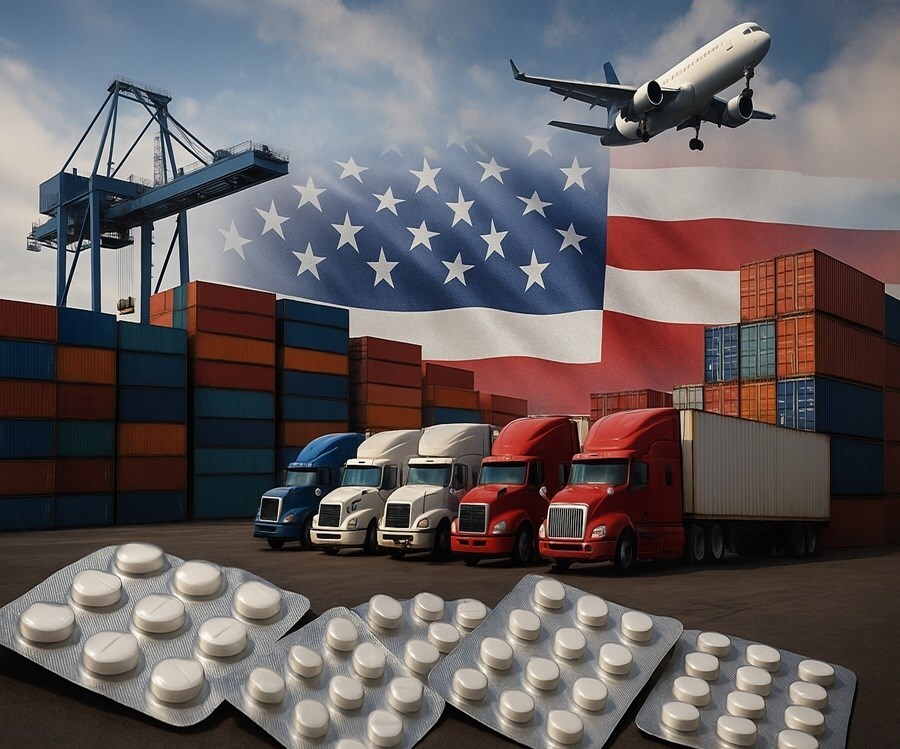

President Donald Trump has moved to expand his trade war on multiple fronts, unveiling tariffs of up to 100 per cent on pharmaceuticals and sharp new duties on heavy trucks and furniture. The announcement marks one of the broadest extensions of his tariff regime so far, aimed at forcing industries to shift production back to US soil.

Pharma, trucks, and furniture in the crosshairs
The tariffs will range from 30 to 100 per cent, with pharmaceuticals facing the steepest increase. A 100 per cent duty is set to apply on imported branded and patented medicines unless companies are already constructing plants inside the United States or if their home countries have specific trade agreements covering pharmaceuticals. Generic medicines are excluded for now, but branded imports—particularly from Ireland, Switzerland, and Germany—will see their prices double for US buyers.
Furniture shipments to the US will face tariffs of between 30 and 50 per cent, while heavy trucks will carry a 25 per cent duty. Both sectors rely heavily on aluminium, which makes the tariff burden even greater. Large commercial trucks contain on average 124 kilograms of aluminium, while smaller models use about 88 kilograms.
The lightweight metal is also increasingly common in office, modular, outdoor, and premium furniture lines, where it is valued for strength and corrosion resistance.
Also read: Aluminium Foil and its End Uses Current Trends and Forecast till 2030
Pressure on pharmaceutical supply chains
The blow to pharmaceuticals is expected to ripple across supply chains worldwide. For US importers and consumers, branded drugs will become significantly more expensive, and analysts warn shortages are possible.
Indian exporters, who dominate the generics market, are mostly shielded from this round of tariffs. But multinational drugmakers in Europe, whose high-value branded medicines make up a major share of US imports, are squarely in the line of fire.
Companies including Eli Lilly, AstraZeneca, Roche, and GSK have already announced large investments in US manufacturing, anticipating tougher trade barriers. Yet the new plants will take years to complete, meaning higher costs and market disruptions are likely in the meantime. If tariffs were ever extended to generic drugs, global shortages could worsen dramatically.
Pharmaceutical packaging also enters the picture. The aluminium packaging market for pharma was worth USD 21.4 billion in 2024 and is forecast to grow to USD 27.6 billion by 2032 as per various sources.
Aluminium foil blister packs, valued at USD 3.5 billion in 2024 and projected to reach USD 5.8 billion by 2033, are a critical part of the industry. With tariffs raising input costs, even packaging could contribute to rising drug prices.
Aviation and aerospace aluminium
Aviation is another sector exposed to tariff pressures through its reliance on aluminium alloys. The aerospace aluminium alloys market was valued at USD 20.5 billion in 2024 and is on track to reach USD 30.8 billion by 2033, growing more than 5 per cent annually. These alloys—particularly the 2xxx and 7xxx series—are used in fuselage panels, wings, and landing gear, where weight reduction improves fuel efficiency and cuts emissions.
Airframe makers are investing in advanced formulations such as aluminium-lithium, which combine high strength with light weight. Tariffs could raise costs across commercial and military aircraft programs, a risk amplified by rising global demand for air travel and the steady expansion of aircraft fleets.
Also read: Boeing aircraft deal emerges as catalyst for US-China tariff relief
Trucks and furniture sectors under strain
For heavy trucks, tariffs add pressure to an industry already dealing with higher aluminium costs. Transportation consumed about 25.5 million tonnes of aluminium in 2021—roughly 27 per cent of total global use—and commercial vehicles accounted for a significant share. By raising import prices, the new duties could push manufacturers to shift production to the US to remain competitive.
Furniture producers face similar choices. Aluminium frameworks and finishes have become increasingly popular in modern designs, particularly in higher-value export-oriented products. With tariffs of up to 50 per cent, overseas manufacturers risk losing ground in the US market unless they localize production or renegotiate trade access.
Semiconductors and the 1:1 rule
Beyond physical goods, the Trump administration is also targeting technology supply chains. According to reports, the US plans to require chipmakers to manufacture domestically the same number of semiconductors as their customers import, enforcing a 1:1 ratio. Firms that fail to maintain this balance could face new tariffs.
This strategy is expected to accelerate reshoring in the semiconductor sector but will demand heavy capital spending and a reworking of supply chains worldwide. Analysts caution that the rule may raise costs and shift global competitiveness at a time when chip markets are already under strain from geopolitical tensions.
Farmers and legal uncertainty
Trump has also suggested that revenue collected from tariffs could be redirected to farmers, many of whom are already struggling with the fallout. “For a little while, they’re going to be hurt until the tariffs kick into their benefit,” the president said. The mechanism for such payouts remains unclear, and legal challenges could block the plan.
The Supreme Court is preparing to review the legality of the tariffs. Lower courts have already ruled against the administration in related cases, raising the possibility that the White House could be forced to refund billions of dollars in tariff revenue
The sweeping tariff expansion underscores both the ambition and volatility of Trump’s trade strategy. By targeting industries from pharmaceuticals to aerospace, the administration is betting that higher costs today will drive factories, jobs, and investment back to US soil. Whether that gamble pays off—or instead leaves consumers, farmers, and global partners bearing the brunt—remains the central question as trade talks and legal battles unfold.
Also read: Aluminium China: 2025 & Beyond
Responses








